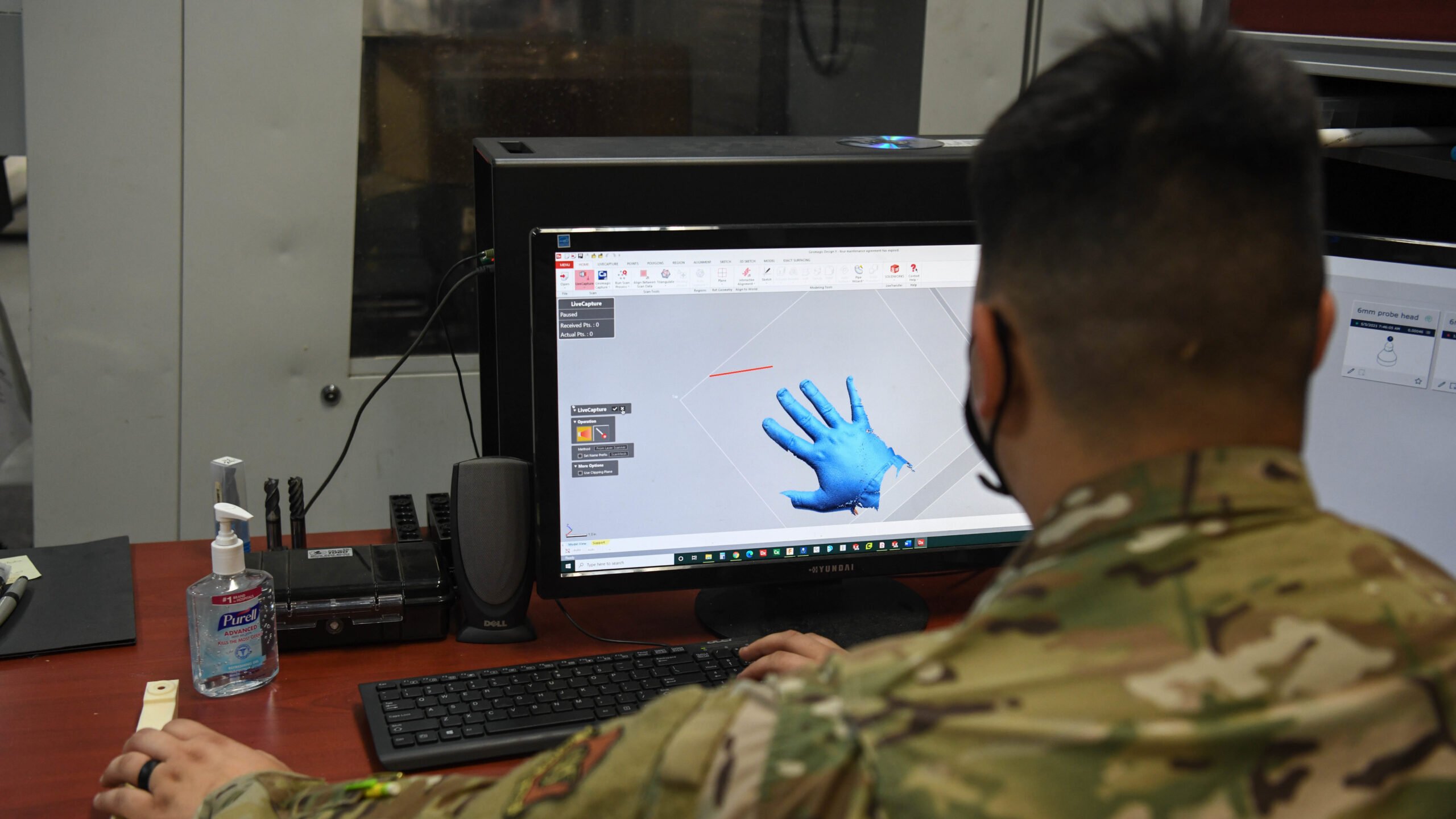
Senior Airman Dominick Ferneding, an aircraft metals technology journeyman from the 18th Equipment Maintenance Squadron, looks at a digital 3D model of his hand during a 3D technology demonstration at Kadena Air Base, Japan, May 7, 2021. (U.S. Air Force photo by Airman 1st Class Anna Nolte)
PHILADELPHIA — Sometime next year the Army will have the first iteration of its digital engineering strategy, a “new-ish” endeavor for the service that a senior official hopes will supercharge Army acquisition.
“The digital engineering end-state looks like basically everything that we have represented today, in documents, that is separate and not connected would be digital,” Jennifer Swanson, deputy assistant secretary of the Army for data, engineering and software, told Breaking Defense on Thursday.
Through digital engineering, the Army wants to move from manual processes to an all digital environment, so much so that Swanson said she hopes Army projects would be “born digital” within a few years. The idea is to speed up the notoriously cumbersome acquisition process, starting with helping to define requirements, Swanson said, which is currently “a completely manual process.”
Beyond acquisition, digital engineering can also help long after the Army has its hands on systems, she said.
“Because in sustainment, we have changes that are required, we have obsolescence of parts — that’s a huge problem. And so if you have a digital model, you can figure out, ‘Okay, well, I can’t get this part. But will this part work?’ And you can do that all digitally before you spend money and bend metal.”
According to a request for information posted earlier this month by the Army, the service currently does not have a trusted digital engineering environment “that fully supports collaboration across stakeholder groups both across the Army’s many development efforts and internal to subordinate components of the Army.”
Swanson said that while the service sees a path ahead with its digital engineering strategy in fiscal 2024 and 2025, “beyond that we’ll be a little less defined.” Speaking at an Army technical exchange meeting, she said the service was looking to industry to help develop the strategy. She further laid out exactly what the service wants in an interview.
“So what we’re looking for from industry is a couple of things: One, from the digital tool industry in particular, who is aligning to standards for digital tool interoperability and what does that look like?” she said on Thursday. “This is all kind of a new thing, digital engineering, new-ish. And so now there are standards that are coming out that industry can align to, and we want to understand, of the digital tool industry, are you or aren’t you? Because I think that will help us to inform our strategy.”
She emphasized that the service doesn’t want vendor lock — when they’re stuck with one company because its systems don’t play nice with others — and wants interoperability between tools “so that it’s an open space and we can continue to pick the best tool for our environment and not worry about exchanging data with other tools,” she added.
Another area that industry can help in is identifying challenges and pitfalls.
“What are some things that we need to think about that are going to be harder to solve as we do this?” she said. “And so that’s been very helpful for us in terms of identifying what are the things we think we can get done earlier, and what are some of the things that are going to have to wait.”
The service hasn’t yet defined all of its lines of efforts within the strategy, but Swanson said training up the workforce to make sure its properly prepared for digital engineering and getting feedback from industry will help develop the strategy further.
Swanson said the Air Force and Navy are “in kind of a similar place as the Army” in their digital engineering strategy, though the Air Force might be a bit ahead, and all three services are sharing their insights.
While the Army works on its strategy, it’s also developing another plan meant to simplify data collection that is slated to wrap up this fiscal year: the Army’s Unified Data Reference Architecture. The first version of that plan will go out in September. Swanson said the service is working with the Pentagon’s Chief Digital and Artificial Intelligence Office to develop the architecture.
“The Unified Data Reference Architecture is… how we’re going to deal with data in the Army and be data-centric,” she said. “Digital engineering, I would say, is a digital wrapper on that, and everything else that we’re doing.”
Both of those plans will bring the service closer to it’s “Army of 2030” vision, which in part calls for a more data-centric and high-tech force.
“I would hope that by 2030, we’ve made our way to a couple of key things: A government-owned and -operated digital engineering environment that allows us to do the pre-award stuff digitally,” Swanson said.
“So putting the requirements in the contracts for what…we expect of industry, from a digital engineering perspective, so that we know when we’re delivering stuff in 2030, it is in a digital framework,” she added.
Global military spending hits ‘all-time high’ of $2.4 trillion: SIPRI report
The US remains the world’s largest defense spender, outlaying $916 billion last year, a 2.3 percent annual increase, ahead of China in second place, which spent an estimated $296 billion, a 6 percent increase over the same period.



























